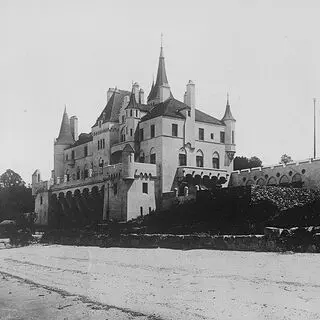
The Great Gatsby Mansions, Part II: Long Island's Lost Gilded Age Mansions
In the afterglow of Baz Luhrmann’s summer adaptation of The Great Gatsby, we looked at some inspirations for the novel's Long Island palaces. Yet many of these grand Gilded Age sites now lie in ruin, while others have been demolished. Here is a look at some of Long Island's lost treasures.

photo by: Library of Congress
Beacon Towers. “Most of the big shore places were closed now and there were hardly any lights except the shadowy, moving glow of a ferryboat across the Sound.”
Beacon Towers was often cited as Fitzgerald’s architectural muse. The Gilded Age château once stood on Sands Point, overlooking the North Shore. It was built from 1917 to 1918 for Alva Belmont, ex-wife of William K. Vanderbilt and then widow of politician Oliver Belmont.
Alva was the kind to summer with her parents in Rhode Island and vacation in Europe. Over her lifetime, she built and owned many mansions; at one point, she owned nine. Beacon Towers was her last built in the U.S. The gleaming, white stucco mansion—and its 140 rooms—was a mix of Gothic architecture with designs inspired by Spanish alcázars.
In 1925, Alva closed the castle and retired to France. It was sold to newspaper magnate William Randolph Hearst in 1927, who resold it in 1942. Beacon Towers was demolished three years later. Today, only the garden walls, gate house, and garage remain.
Stay connected with us via email. Sign up today.
.webp)
photo by: Wikimedia
Harbor Hill. "This is a valley of ashes—a fantastic farm where ashes grow like wheat into ridges and hills and grotesque gardens."
Another fallen mansion is Harbor Hill. The chateau held a striking view of Hempstead Harbor. The vast grounds once included Turkish baths, shooting galleries, and a casino.
Financier Clarence H. Mackay and his wife hosted the most grand parties of the Roaring Twenties there. F. Scott and Zelda attended a fete at Harbor Hill in 1923. Mackay would throw his biggest one yet the next year, hosting it in honor of the Prince of Wales. It featured two orchestras, fountains of perfumed water, floating flower arrangements, and an unapologetically large American flag made of lightbulbs atop the roof.
Mackay left Harbor Hill in 1938. His son, without the means to maintain the property, leased the grounds to the U.S. Army Air Corps as the Roslyn Air Force Station.
The house and other buildings fell into disrepair. The mansion was dynamited in 1947.
One estate recently lost was Lands End, rumored to have inspired the Buchanans’ unhappy home. The Colonial Revival mansion on the tip of Sands Point was sold then demolished in 2011. Once host to the likes of Winston Churchill, the Marx Brothers, and the Fitzgeralds themselves, Lands End will now become a multi-million-dollar housing development.
Long Island local Zach Lemle is dedicated to documenting these disappearing treasures.
“The first part of the 20th century was an extravagant time for those in the upper echelons of society,” Lemle says, “but many of the places that were built were more than just party palaces. Along with the gardens and grounds, these estates were works of art.”
These mansions stand for a unique moment in American social and cultural history—and not just for their parties. Not only do they showcase the work of America’s talented architects and landscapists, the mansions’ presence also dictated developments like the Long Island Railroad and highways, Lemle explains.
Today, their existence gives everyone else a chance to experience, if for a fleeting moment, that glittering past.

photo by: Minnesota Historical Society
F. Scott and Zelda Fitzgerald were guests at Harbor Hill and Lands End's famous parties.
“There have been far too many demolitions of historic houses on Long Island, and the threat is still with us today," Lemle says. "Perhaps, if we can just bring more of these places into the light, then more people will become aware of their significance and we'll stop destroying our past."
See other threatened sites in the Long Island area at the Preservation Long Island website.
Want more? Check out: The Great Gatsby Mansions: Real-Life Homes That Inspired the Book and FilmReal-Life Homes That Inspired the Book and Film
Donate Today to Help Save the Places Where Our History Happened.
Donate to the National Trust for Historic Preservation today and you'll help preserve places that tell our stories, reflect our culture, and shape our shared American experience.


